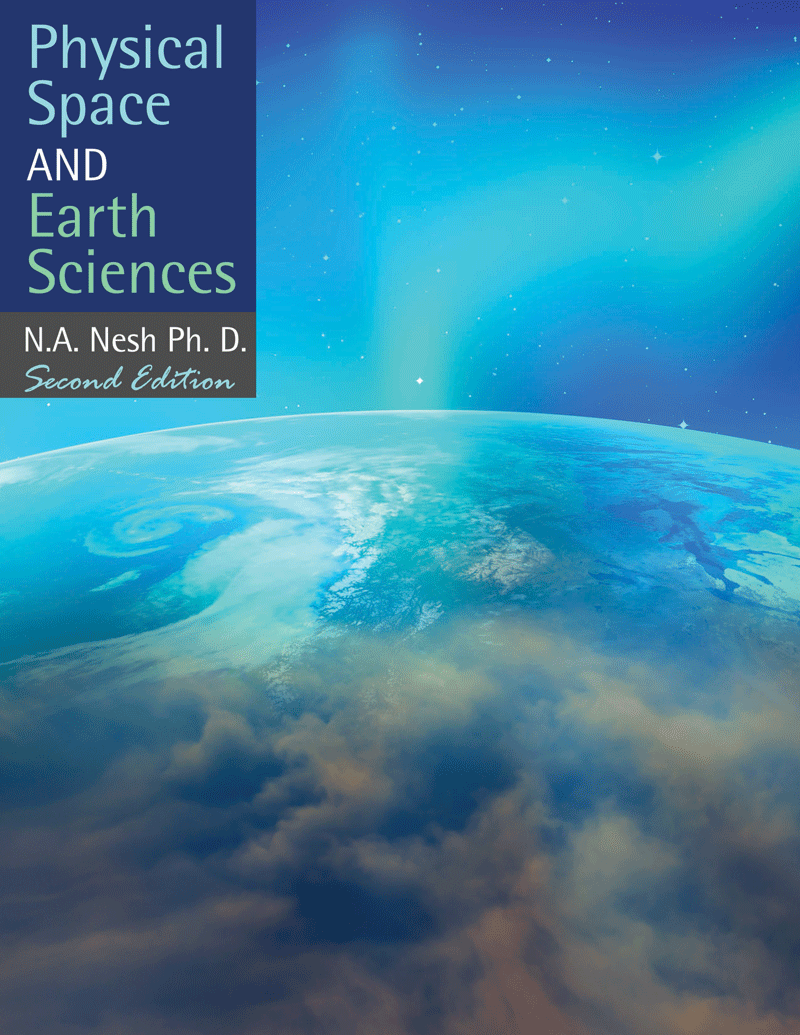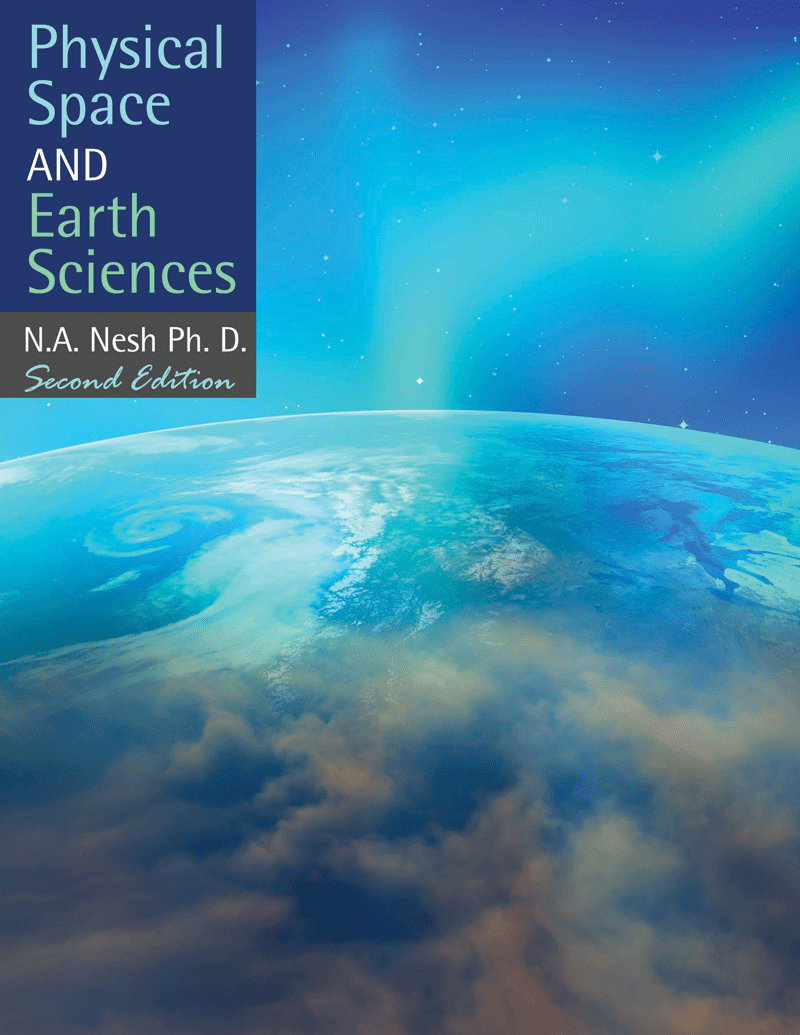Physical Space and Earth Sciences
Author(s): Nicholas A. Nesh
Edition: 3
Copyright: 2024
Pages: 680
This book is the result of the author's twenty-five years of college teaching experience. It is designed to help non-science majors fulfill their natural science course requirements as a part of their general studies. The book is geared toward students with no prior familiarity with college-level physical science courses; only algebra-based formulas are used. The book combines conceptual understanding with problem-solving skills. As such, it features a large number of in-chapter, solved examples and a variety of end-of-chapter problems and questions. The uniqueness of the book lies in its coverage of physics, astronomy, and earth science concepts in a single, self-contained volume. Covered topics include mechanics, thermal physics, fluids, electromagnetism, the Universe, and the Earth's interior, surface, waters, and atmosphere. Chapter organization is flexible, allowing the instructor to select the order of topics and depth of coverage as appropriate for a one- or two-semester course.
CHAPTER 1 MEASUREMENTS
1-1 The SI System of Units
1-2 Metric Prefixes
1-3 Derived Units in the SI System
1-4 Unit Conversions
1-5 Density, Mass, and Weight
1-5-1 Measurement of Mass
1-5-2 Measurement of Volume
1-5-3 Density
1-5-4 Measurement of Length
1-6 Scientific Notation
1-7 Experimental Errors and Precision
1-8 Graphs and Variables
Chapter Summary
Important Terms
Questions and Exercises
CHAPTER 2 MOTION
2-1 Position
2-2 Displacement and Distance
2-3 Velocity and Speed
2-4 Graphic Determination of Speed
2-5 Acceleration
2-6 Motion with Constant Acceleration
2-7 Graphic Analysis of Accelerated Motion
2-8 Free Fall Motion
2-9 Projectile Motion
Chapter Summary
Important Terms
Questions and Exercises
CHAPTER 3 FORCE AND MOTION
3-1 Forces
3-2 Inertia and Mass
3-3 Newton’s First Law of Motion
3-4 Newton’s Second Law of Motion
3-5 Newton’s Third Law of Motion
3-6 The Law of Universal Gravitation
3-7 Weight
3-8 Rockets
3-9 Uniform Circular Motion
3-10 Torques
3-11 Center of Mass and Rotation
Chapter Summary
Important Terms
Questions and Exercises
CHAPTER 4 ENERGY, WORK, AND MOMENTUM
4-1 Work and Energy
4-2 Work, Force, and Displacement
4-3 Mechanical Energy
4-4 Kinetic Energy
4-5 Potential Energy
4-5-1 Gravitational Potential Energy
4-5-2 Elastic Potential Energy
4-6 The Law of Conservation of Energy
4-7 Power
4-8 Momentum
4-9 Collisions
4-10 Impulse
Chapter Summary
Important Terms
Questions and Exercises
CHAPTER 5 TEMPERATURE AND HEAT
5-1 Thermal Energy and Temperature
5-2 Temperature Scales
5-3 Temperature Conversions
5-4 Heat
5-5 Phase Changes
5-6 Conduction
5-7 Convection
5-8 Radiation
5-9 Insulation
5-10 The Greenhouse Effect
5-11 Pressure in Fluids
Chapter Summary
Important Terms
Questions and Exercises
CHAPTER 6 OSCILLATIONS AND WAVES
6-1 Waves
6-2 Wave Properties
6-3 Wave Speed
6-4 Sound Waves
Chapter Summary
Important Terms
Questions and Exercises
CHAPTER 7 ELECTRICITY
7-1 Static Electricity
7-2 Electric Charges
7-3 Coulomb’s Law
7-4 Conductors and Insulators
7-5 Electric Fields
7-6 Electric Potential Energy
7-7 Potential Difference
7-8 Electric Currents
7-9 Components of Electric Circuits
7-10 Ohm’s Law
7-11 Electric Power
7-12 Series and Parallel Circuits
7-13 DC and AC Currents
Chapter Summary
Important Terms
Questions and Exercises
CHAPTER 8 MAGNETISM AND ELECTRODYNAMICS
8-1 Magnetism
8-2 Magnetic Poles
8-3 Magnetic Fields
8-4 Types of Magnets
8-5 The Earth’s Magnetism
8-6 Electromagnetic Induction
8-7 Transformers
Chapter Summary
Important Terms
Questions and Exercises
CHAPTER 9 LIGHT
9-1 Light as an Electromagnetic Wave
9-2 Electromagnetic (EM) Spectrum
9-3 Wien’s Law 2
9-4 Reflection of Light
9-5 Images Formed by Plane Mirror
9-6 Curved Mirrors
9-7 Images Formed by Curved Mirrors
9-8 Refraction of Light
9-9 Rayleigh Scattering
9-9-1 Sunsets and Blue Sky
9-9-2 How Rainbows Form
9-10 Lenses
9-11 Uses of Optics
9-12 Human Eye
Chapter Summary
Important Terms
Questions and Exercises
CHAPTER 10 THE UNIVERSE
10-1 Cosmological Models of the Universe
10-2 Formation and Types of Galaxies
10-3 Formation of Stars
10-4 The Main Sequence Stage
10-5 The Red Giant Stage
10-6 The White Dwarf Stage
10-7 Supernovas
10-8 Neutron Stars
10-9 Black Holes
Important Terms
Questions and Exercises
CHAPTER 11 THE SOLAR SYSTEM AND THE EARTH
11-1 Structure of the Solar System
11-2 Formation of the Solar System
11-3 The Sun’s Past
11-4 Members of the Solar System
11-5 Origins of the Earth and the Moon
11-6 Earth’s Shape and Size
11-7 Earth in Motion
11-8 The Earth-Moon System
11-9 Phases of the Moon
11-10 Solar and Lunar Eclipses
11-11 Tides
Important Terms
Questions and Exercises
CHAPTER 12 EARTH’S INTERIOR AND PLATE TECTONICS
12-1 Earth’s Structure
12-2 The Earth’s Interior
12-3 The Earth’s Crust
12-4 Plate Tectonics
12-5 Minerals and Rocks
12-6 Rock Types
Important Terms
Questions and Exercises
CHAPTER 13 THE EARTH’S SURFACE
13-1 Surface of the Earth
13-2 Earthquakes
13-3 Measuring Earthquakes
13-4 Earthquake Effects
13-5 Using Earthquakes to Study the Earth’s Interior
13-6 Volcanoes
13-7 Hurricanes
Important Terms
Questions and Exercises
CHAPTER 14 THE EARTH’S ATMOSPHERE
14-1 Composition of the Atmosphere
14-2 Atmospheric Pressure
14-3 The Greenhouse Effect
14-4 The Solar Energy Budget
14-5 Global Temperature Patterns
14-6 Daily Temperature Variations
Important Terms
Questions and Exercises
CHAPTER 15 THE EARTH’S WATERS
15-1 The Earth’s Ocean
15-2 Hydrological Cycle
15-3 Fresh Water on Earth
Important Terms
Questions and Exercises
APPENDICES
Appendix I The International System of Units (SI)
Appendix II Conversion Factors
Appendix III Important Physical Constants
Appendix IV Greek Alphabet
Appendix V Mathematical Formulas and Symbols
Appendix VI Select Astronomical Data
Appendix VII Periodic Table of Elements
Appendix VIII Answers to Questions and Exercises
This book is the result of the author's twenty-five years of college teaching experience. It is designed to help non-science majors fulfill their natural science course requirements as a part of their general studies. The book is geared toward students with no prior familiarity with college-level physical science courses; only algebra-based formulas are used. The book combines conceptual understanding with problem-solving skills. As such, it features a large number of in-chapter, solved examples and a variety of end-of-chapter problems and questions. The uniqueness of the book lies in its coverage of physics, astronomy, and earth science concepts in a single, self-contained volume. Covered topics include mechanics, thermal physics, fluids, electromagnetism, the Universe, and the Earth's interior, surface, waters, and atmosphere. Chapter organization is flexible, allowing the instructor to select the order of topics and depth of coverage as appropriate for a one- or two-semester course.
CHAPTER 1 MEASUREMENTS
1-1 The SI System of Units
1-2 Metric Prefixes
1-3 Derived Units in the SI System
1-4 Unit Conversions
1-5 Density, Mass, and Weight
1-5-1 Measurement of Mass
1-5-2 Measurement of Volume
1-5-3 Density
1-5-4 Measurement of Length
1-6 Scientific Notation
1-7 Experimental Errors and Precision
1-8 Graphs and Variables
Chapter Summary
Important Terms
Questions and Exercises
CHAPTER 2 MOTION
2-1 Position
2-2 Displacement and Distance
2-3 Velocity and Speed
2-4 Graphic Determination of Speed
2-5 Acceleration
2-6 Motion with Constant Acceleration
2-7 Graphic Analysis of Accelerated Motion
2-8 Free Fall Motion
2-9 Projectile Motion
Chapter Summary
Important Terms
Questions and Exercises
CHAPTER 3 FORCE AND MOTION
3-1 Forces
3-2 Inertia and Mass
3-3 Newton’s First Law of Motion
3-4 Newton’s Second Law of Motion
3-5 Newton’s Third Law of Motion
3-6 The Law of Universal Gravitation
3-7 Weight
3-8 Rockets
3-9 Uniform Circular Motion
3-10 Torques
3-11 Center of Mass and Rotation
Chapter Summary
Important Terms
Questions and Exercises
CHAPTER 4 ENERGY, WORK, AND MOMENTUM
4-1 Work and Energy
4-2 Work, Force, and Displacement
4-3 Mechanical Energy
4-4 Kinetic Energy
4-5 Potential Energy
4-5-1 Gravitational Potential Energy
4-5-2 Elastic Potential Energy
4-6 The Law of Conservation of Energy
4-7 Power
4-8 Momentum
4-9 Collisions
4-10 Impulse
Chapter Summary
Important Terms
Questions and Exercises
CHAPTER 5 TEMPERATURE AND HEAT
5-1 Thermal Energy and Temperature
5-2 Temperature Scales
5-3 Temperature Conversions
5-4 Heat
5-5 Phase Changes
5-6 Conduction
5-7 Convection
5-8 Radiation
5-9 Insulation
5-10 The Greenhouse Effect
5-11 Pressure in Fluids
Chapter Summary
Important Terms
Questions and Exercises
CHAPTER 6 OSCILLATIONS AND WAVES
6-1 Waves
6-2 Wave Properties
6-3 Wave Speed
6-4 Sound Waves
Chapter Summary
Important Terms
Questions and Exercises
CHAPTER 7 ELECTRICITY
7-1 Static Electricity
7-2 Electric Charges
7-3 Coulomb’s Law
7-4 Conductors and Insulators
7-5 Electric Fields
7-6 Electric Potential Energy
7-7 Potential Difference
7-8 Electric Currents
7-9 Components of Electric Circuits
7-10 Ohm’s Law
7-11 Electric Power
7-12 Series and Parallel Circuits
7-13 DC and AC Currents
Chapter Summary
Important Terms
Questions and Exercises
CHAPTER 8 MAGNETISM AND ELECTRODYNAMICS
8-1 Magnetism
8-2 Magnetic Poles
8-3 Magnetic Fields
8-4 Types of Magnets
8-5 The Earth’s Magnetism
8-6 Electromagnetic Induction
8-7 Transformers
Chapter Summary
Important Terms
Questions and Exercises
CHAPTER 9 LIGHT
9-1 Light as an Electromagnetic Wave
9-2 Electromagnetic (EM) Spectrum
9-3 Wien’s Law 2
9-4 Reflection of Light
9-5 Images Formed by Plane Mirror
9-6 Curved Mirrors
9-7 Images Formed by Curved Mirrors
9-8 Refraction of Light
9-9 Rayleigh Scattering
9-9-1 Sunsets and Blue Sky
9-9-2 How Rainbows Form
9-10 Lenses
9-11 Uses of Optics
9-12 Human Eye
Chapter Summary
Important Terms
Questions and Exercises
CHAPTER 10 THE UNIVERSE
10-1 Cosmological Models of the Universe
10-2 Formation and Types of Galaxies
10-3 Formation of Stars
10-4 The Main Sequence Stage
10-5 The Red Giant Stage
10-6 The White Dwarf Stage
10-7 Supernovas
10-8 Neutron Stars
10-9 Black Holes
Important Terms
Questions and Exercises
CHAPTER 11 THE SOLAR SYSTEM AND THE EARTH
11-1 Structure of the Solar System
11-2 Formation of the Solar System
11-3 The Sun’s Past
11-4 Members of the Solar System
11-5 Origins of the Earth and the Moon
11-6 Earth’s Shape and Size
11-7 Earth in Motion
11-8 The Earth-Moon System
11-9 Phases of the Moon
11-10 Solar and Lunar Eclipses
11-11 Tides
Important Terms
Questions and Exercises
CHAPTER 12 EARTH’S INTERIOR AND PLATE TECTONICS
12-1 Earth’s Structure
12-2 The Earth’s Interior
12-3 The Earth’s Crust
12-4 Plate Tectonics
12-5 Minerals and Rocks
12-6 Rock Types
Important Terms
Questions and Exercises
CHAPTER 13 THE EARTH’S SURFACE
13-1 Surface of the Earth
13-2 Earthquakes
13-3 Measuring Earthquakes
13-4 Earthquake Effects
13-5 Using Earthquakes to Study the Earth’s Interior
13-6 Volcanoes
13-7 Hurricanes
Important Terms
Questions and Exercises
CHAPTER 14 THE EARTH’S ATMOSPHERE
14-1 Composition of the Atmosphere
14-2 Atmospheric Pressure
14-3 The Greenhouse Effect
14-4 The Solar Energy Budget
14-5 Global Temperature Patterns
14-6 Daily Temperature Variations
Important Terms
Questions and Exercises
CHAPTER 15 THE EARTH’S WATERS
15-1 The Earth’s Ocean
15-2 Hydrological Cycle
15-3 Fresh Water on Earth
Important Terms
Questions and Exercises
APPENDICES
Appendix I The International System of Units (SI)
Appendix II Conversion Factors
Appendix III Important Physical Constants
Appendix IV Greek Alphabet
Appendix V Mathematical Formulas and Symbols
Appendix VI Select Astronomical Data
Appendix VII Periodic Table of Elements
Appendix VIII Answers to Questions and Exercises

